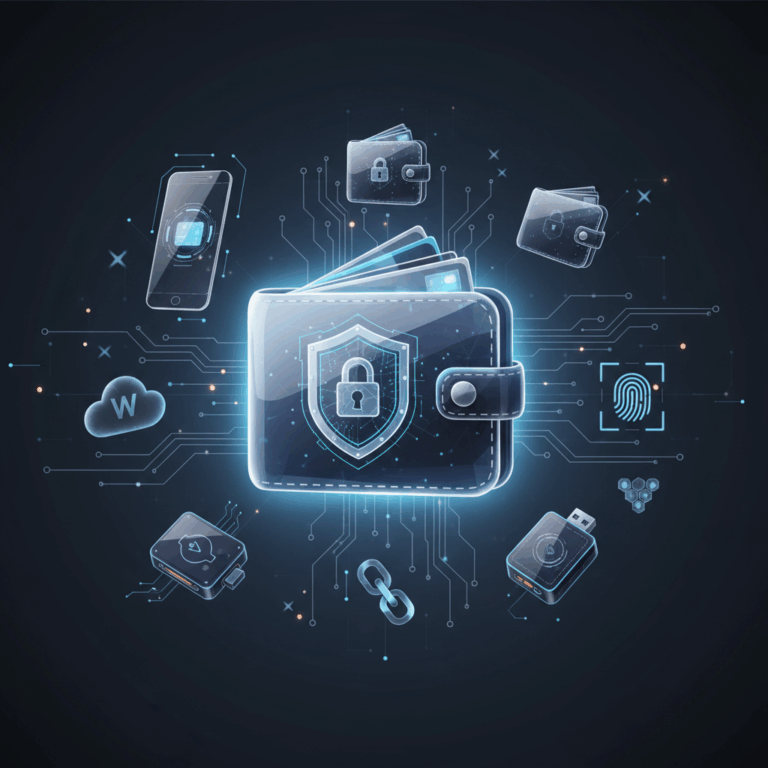Types of digital wallets
The digital wallets They are essential tools for storing and managing cryptocurrencies. There are several types, each with specific features and security levels.
Understanding the differences between these types helps in choosing the right option based on the intended use, desired safety, and user comfort.
Hardware wallets
The hardware wallets They are independent physical devices that store private keys offline, thus providing high protection against cyberattacks.
Popular examples include the Ledger Nano S and Trezor Model T. These offer superior security, but can be expensive and present a risk of physical loss if not properly backed up.
They are ideal for those looking to store large quantities or maintain their assets long-term, minimizing the risk of unauthorized online access.
Software, web, and paper portfolios
The software portfolios They include mobile and desktop applications, such as Trust Wallet or MetaMask, which allow you to easily manage cryptocurrencies from connected devices.
The web wallets They offer browser access and multiple synchronization, although they depend on the provider's security and can be vulnerable to attacks.
The paper wallets They print private keys and QR codes; although they are secure if well protected, their physical fragility can pose a risk of permanent loss.
Key security aspects of wallets
The digital wallet security It is essential to protect cryptocurrencies against theft and loss. It requires robust mechanisms such as encryption, backups, and proper key management.
Understanding these key aspects helps minimize risks and ensure that funds remain accessible and secure, for both novice and advanced users.
Encryption, backup, and recovery
He strong encryption It protects the information stored in the wallet, preventing unauthorized access even if the device or file is compromised.
It is crucial to have options for backup and recovery, such as seed phrases or backup files, to restore the wallet in case of loss or damage to the device.
These systems prevent the irreversible loss of access to digital assets, ensuring that the user does not depend exclusively on a single medium or device.
Private key management
The private keys They are the essence of cryptocurrencies; whoever controls them can move the funds, so their handling must be secure and discreet.
Non-custodial wallets give the user full control, while custodial wallets delegate responsibility to a third party, increasing trust but creating dependency.
Storing passwords in offline environments or on separate devices significantly reduces the risk of digital theft.
Risks and protection against attacks
Wallets are exposed to multiple threats, such as malware, phishing, and hacking. Adopting strong passwords and two-factor authentication improves your defenses.
It is vital to keep software and firmware up to date, and to be wary of suspicious links or applications to avoid compromising security.
Using cold wallets or hardware wallets also minimizes the attack surface, keeping keys away from the online environment and reducing vulnerabilities.
Criteria for choosing the best digital wallet
Select the best digital wallet It depends on several factors that balance security, compatibility and ease of use, adapting to the user's profile and the nature of their assets.
Analyzing these criteria allows for an informed decision that guarantees protection and convenience in the daily management of cryptocurrencies.
Security level according to use and assets
He security level It should be adjusted to the value and frequency of use of the assets. For large sums or long-term storage, a hardware portfolio is recommended.
For everyday transactions with smaller amounts, software or web wallets offer agility, always applying measures such as two-factor authentication and strong passwords.
Considering the type of custodian also helps to assess the risk; non-custodial wallets offer full control, while custodial wallets rely on third parties to protect the keys.
Compatibility and ease of use
The compatibility Using specific cryptocurrencies and user devices is essential to avoid technical problems and facilitate transactions.
The intuitive interface and support resources are key for novice users, contributing to a safer and more satisfying experience.
In addition, it is important to evaluate the provider's reputation and the frequency of updates to ensure that the digital portfolio has constant improvements and reliable support.
Recommendations for users of digital wallets
Choosing the right digital wallet depends on the user's profile and needs. It's essential to assess how often they'll use it and the amount they want to manage in order to select the safest and most practical option.
Furthermore, considering technical expertise and personal preferences facilitates convenient and efficient management of digital assets, optimizing protection and accessibility.
Choice according to profile and needs
For users with large investments or those looking to store their assets long-term, a hardware portfolio due to its high security and offline storage.
Frequent users or beginners can choose software portfolioswhich facilitate daily transactions and have intuitive interfaces.
In both cases, evaluating the wallet's features based on the number of supported cryptocurrencies and ease of key recovery is vital to prevent losses.
Importance of support and reputation
Choosing a wallet with Reliable technical support Quick help is guaranteed for problems or doubts, which is crucial for the user's peace of mind.
The provider's reputation also indicates the quality and security of the service. A portfolio with an active community and constant updates reduces vulnerabilities.






